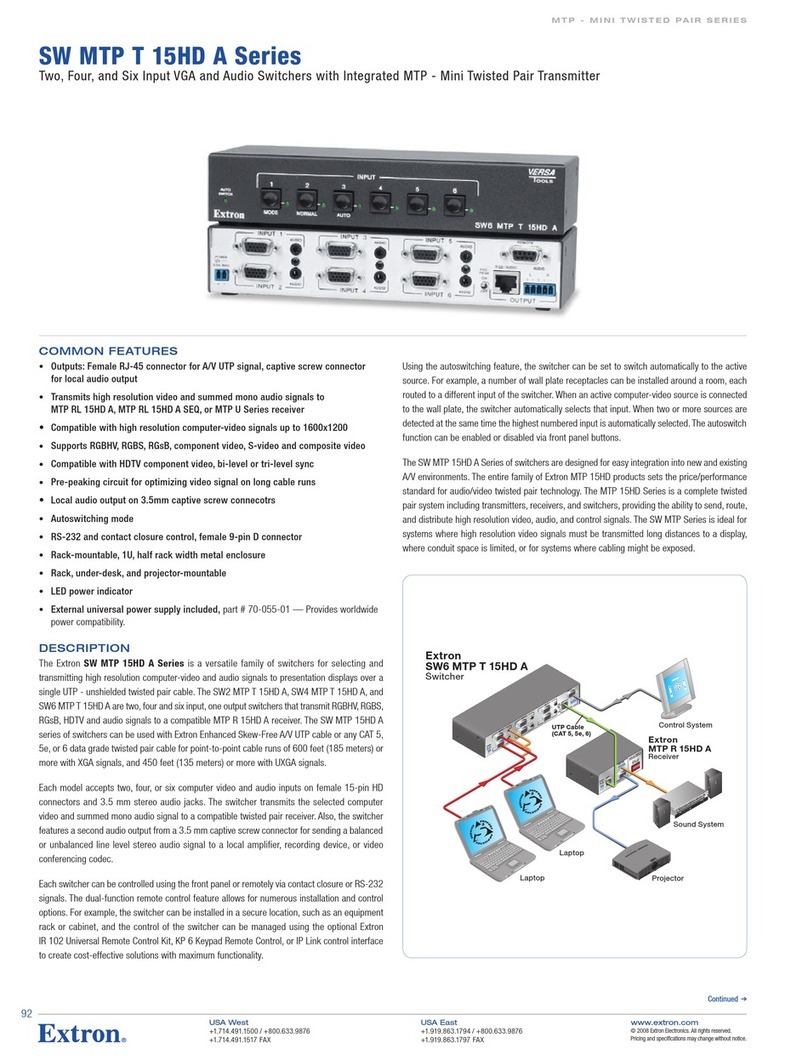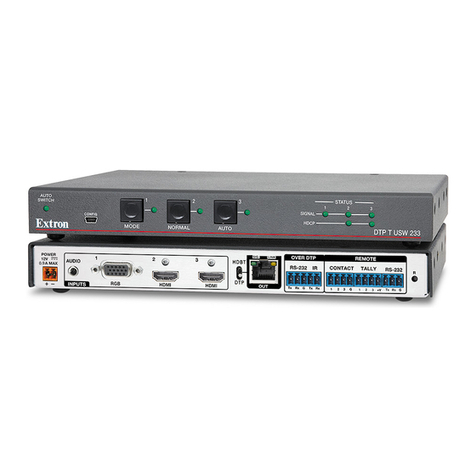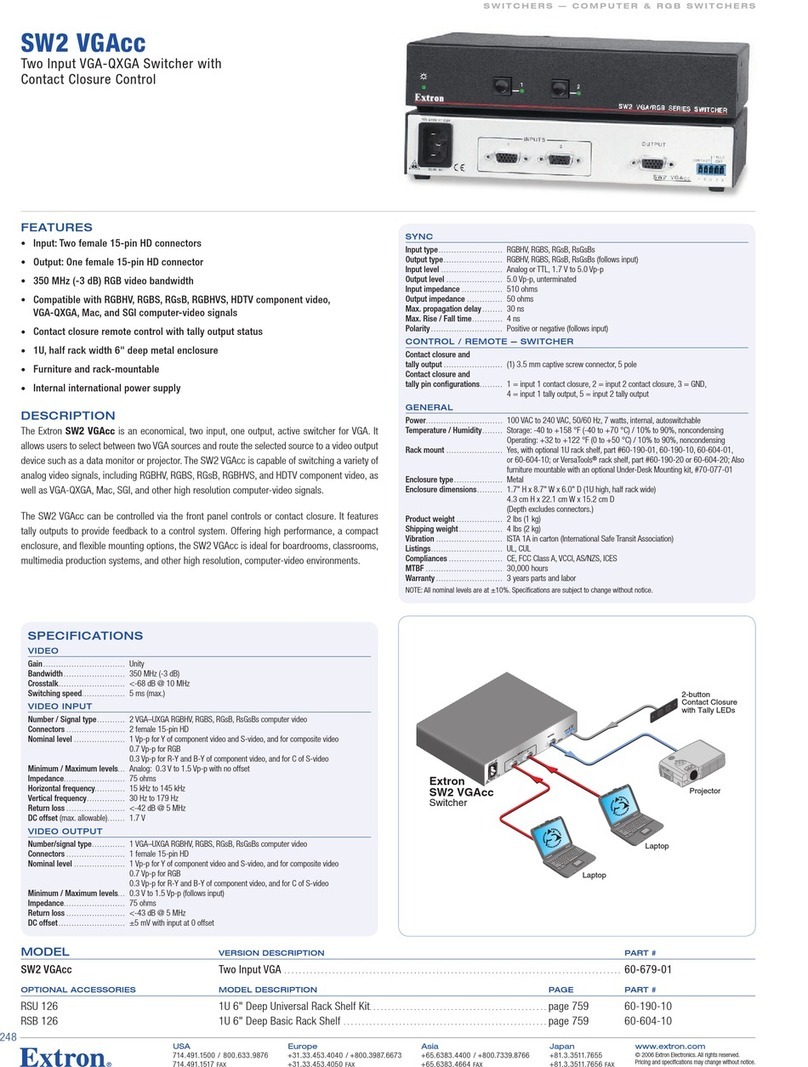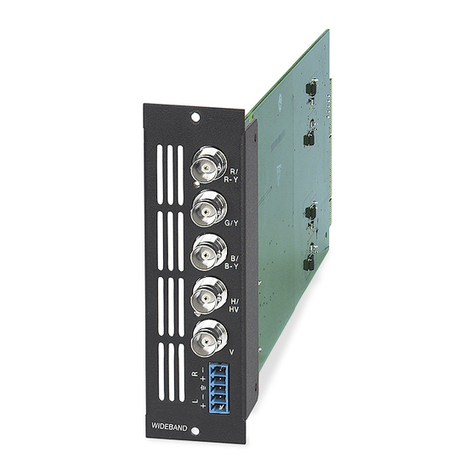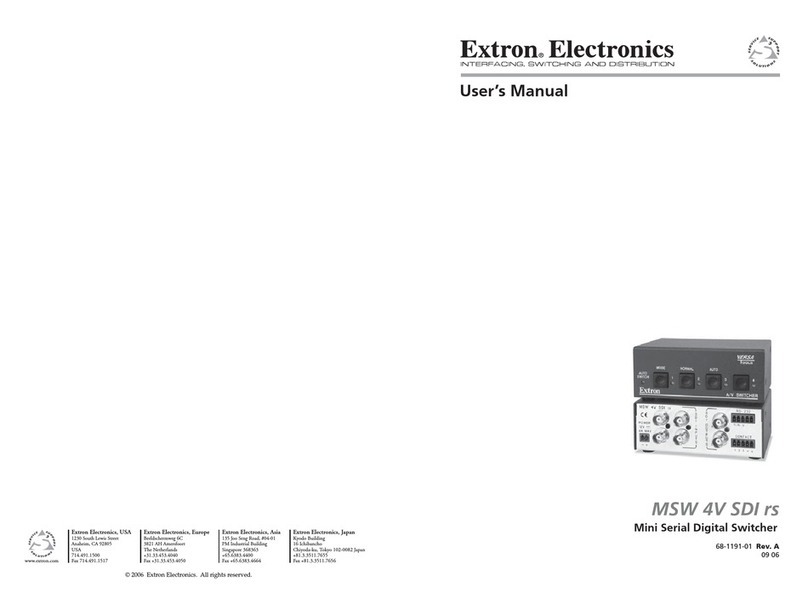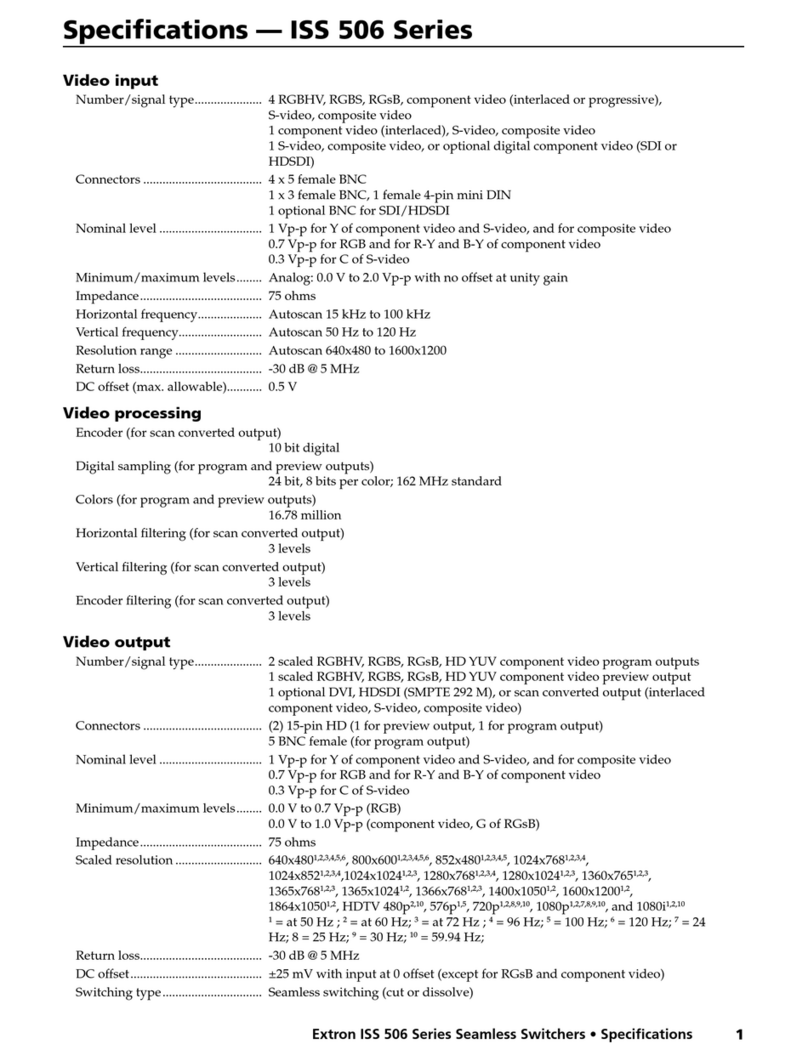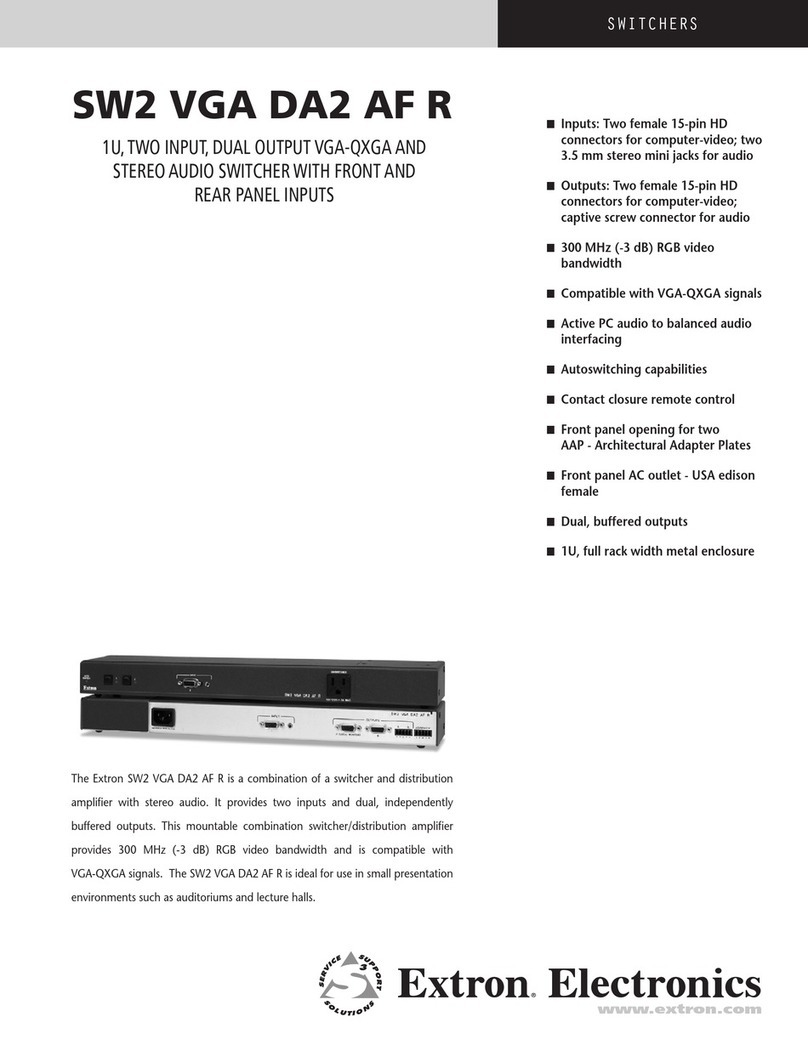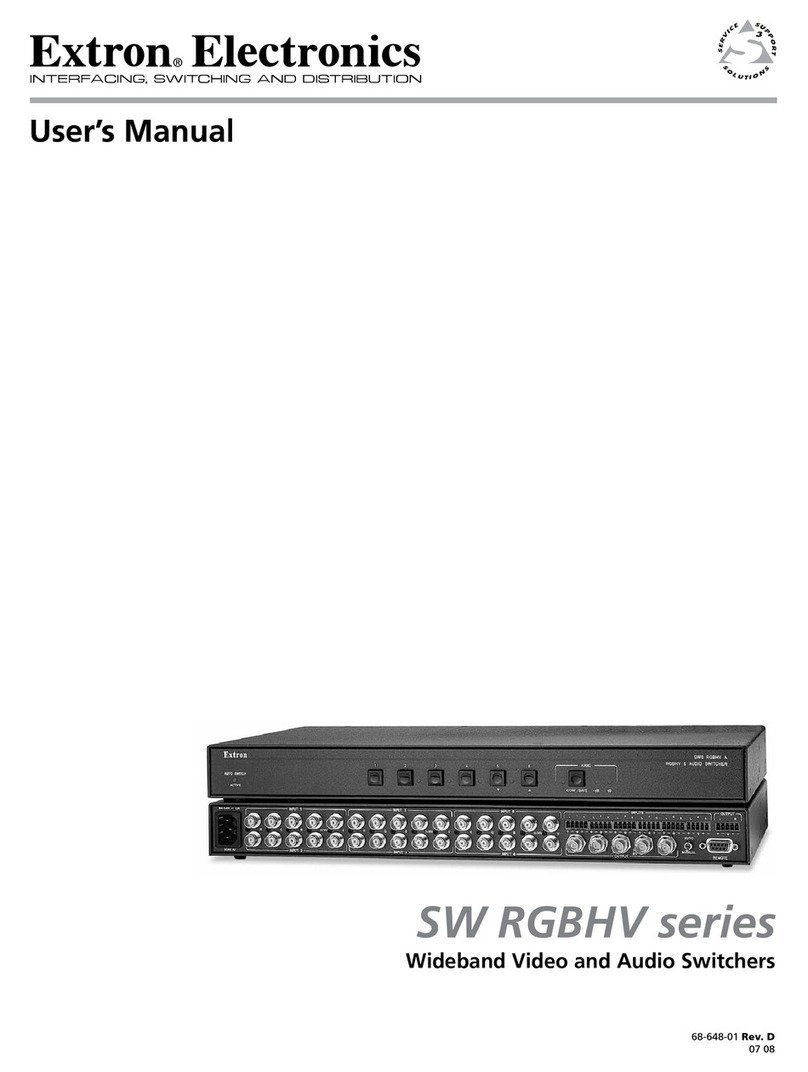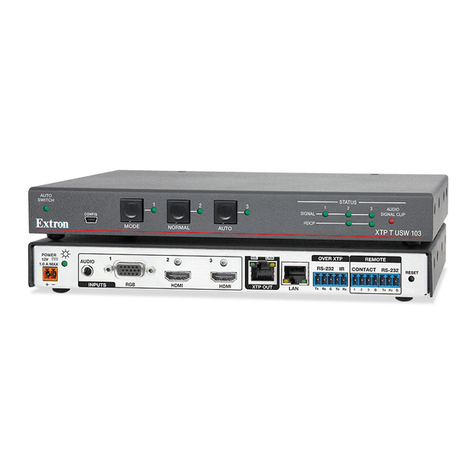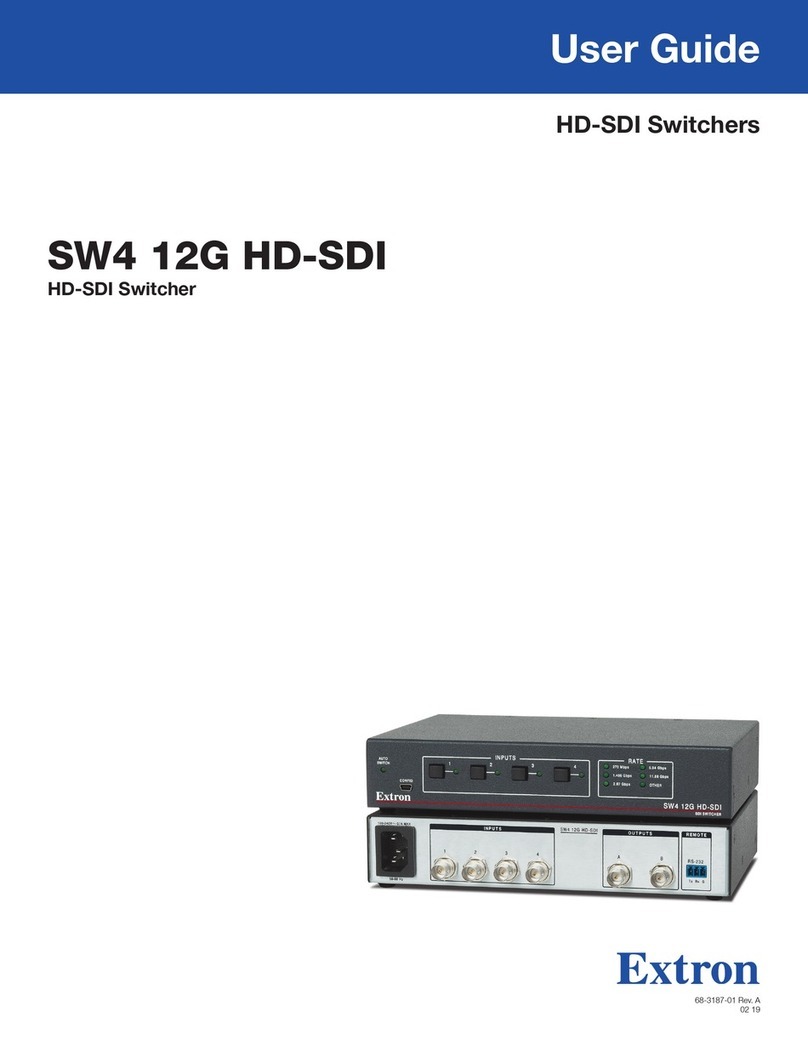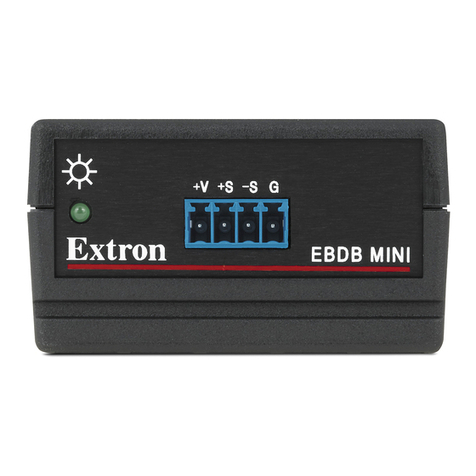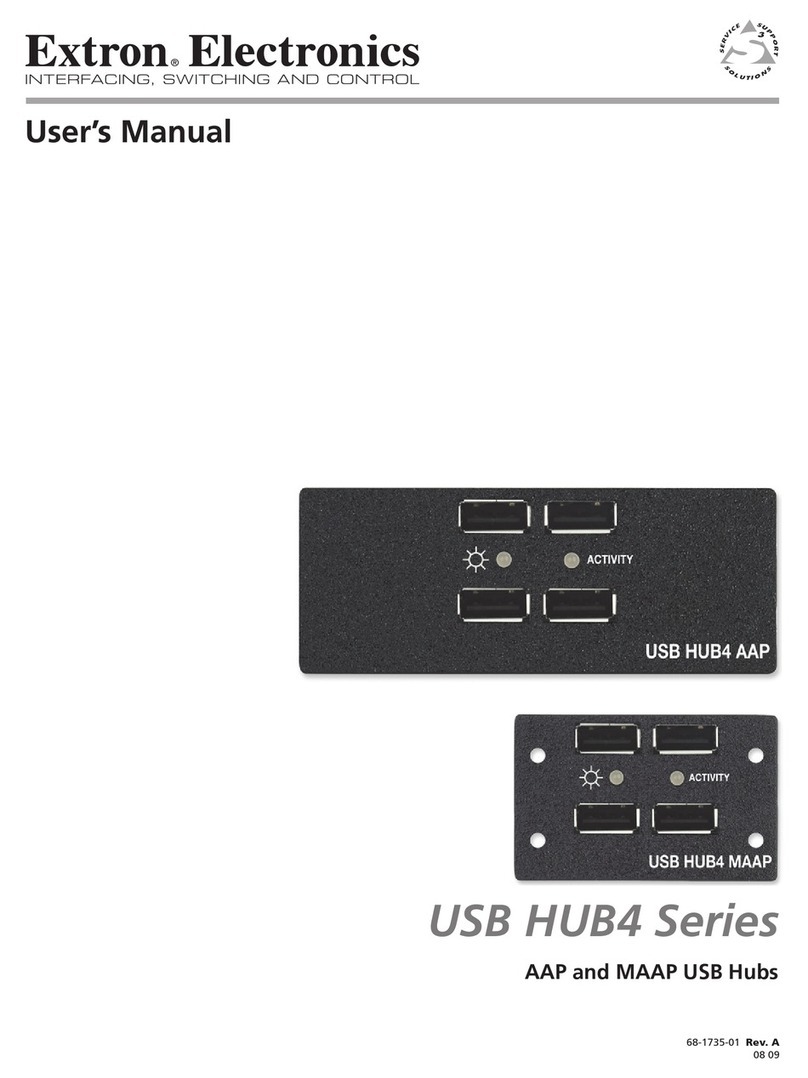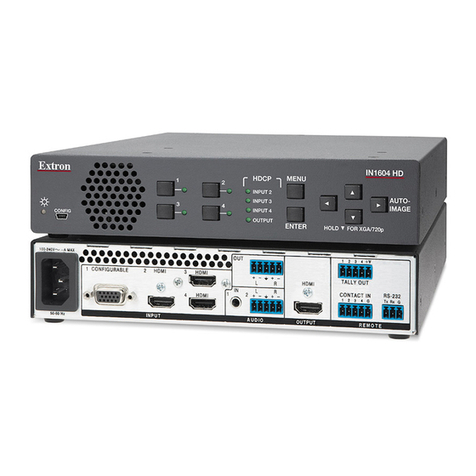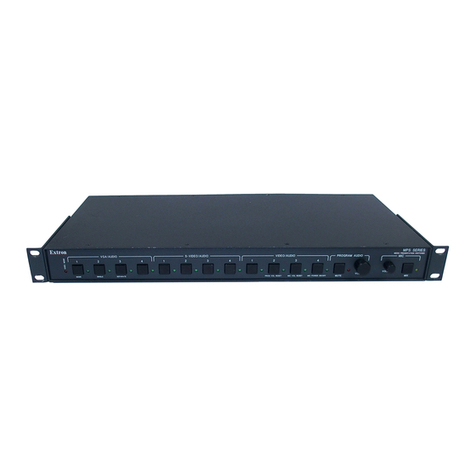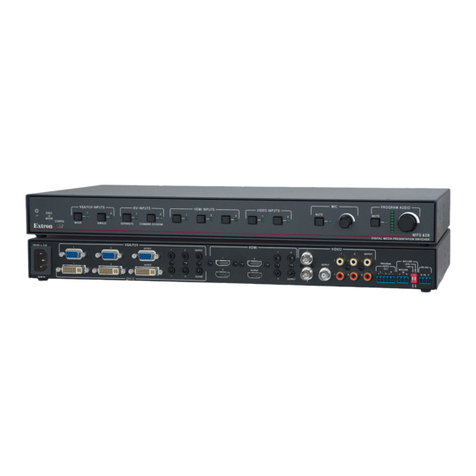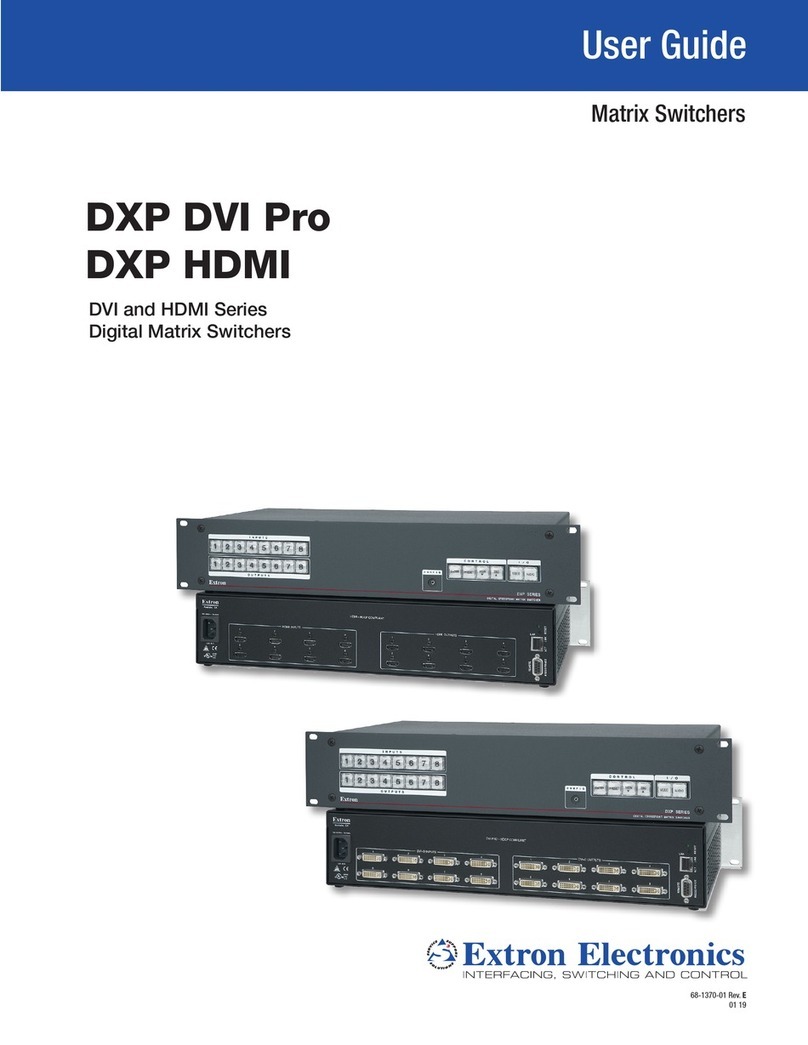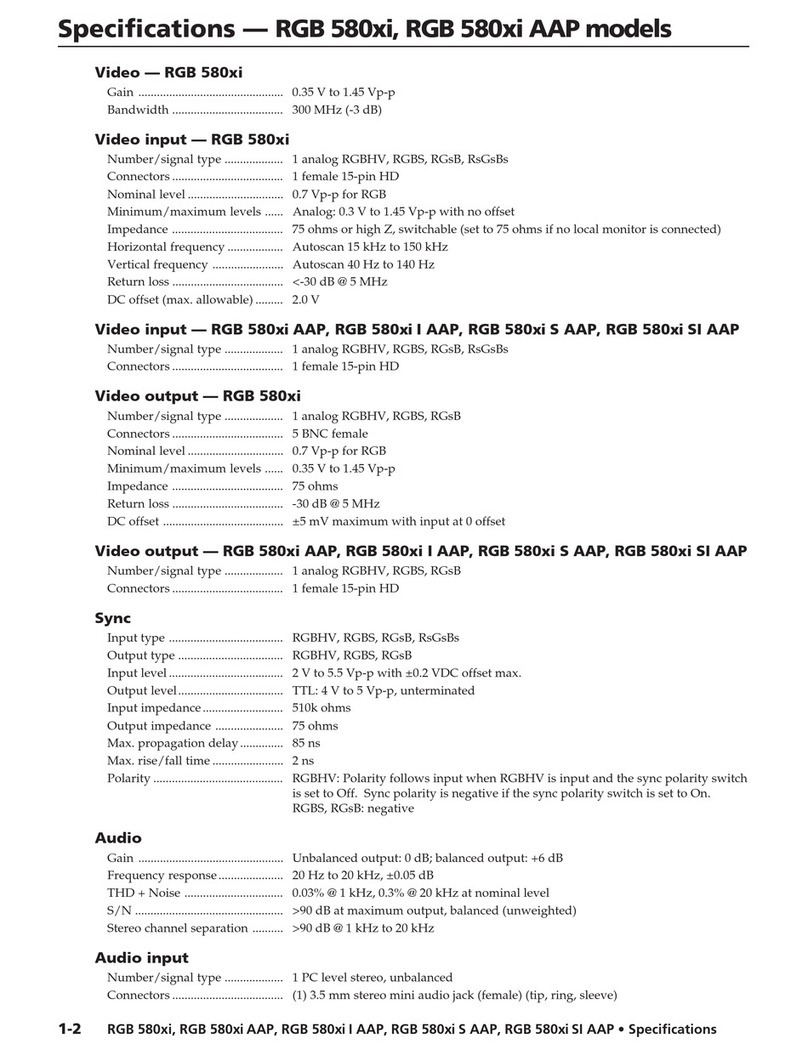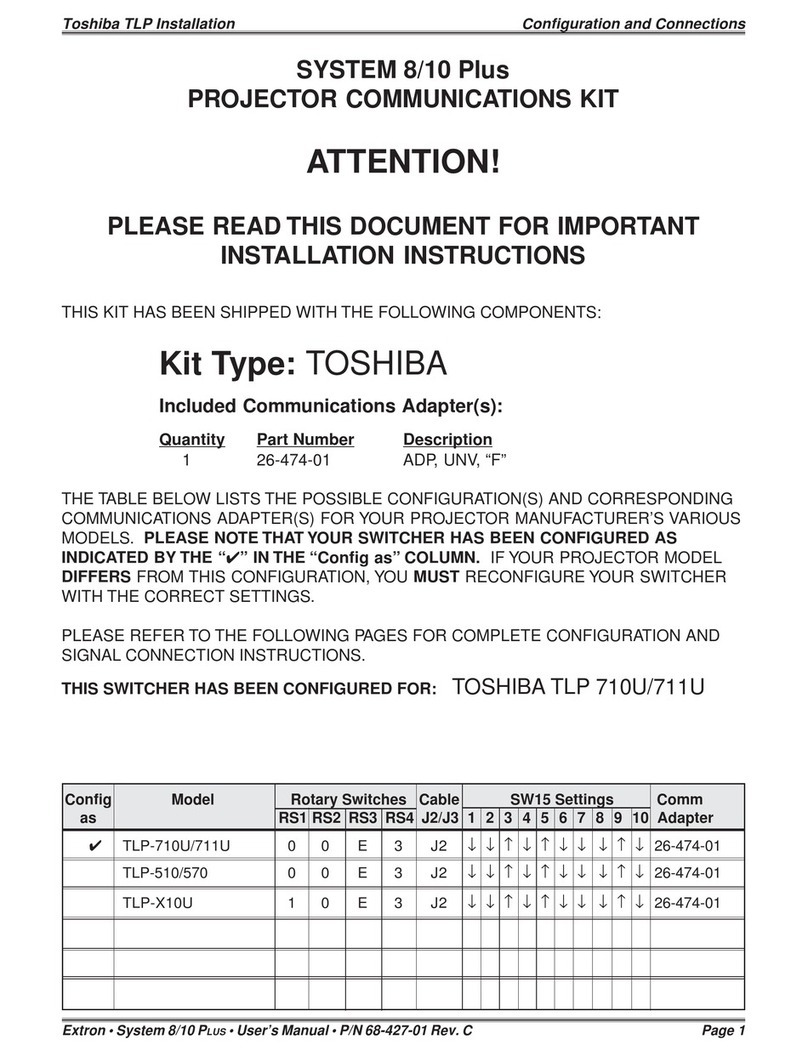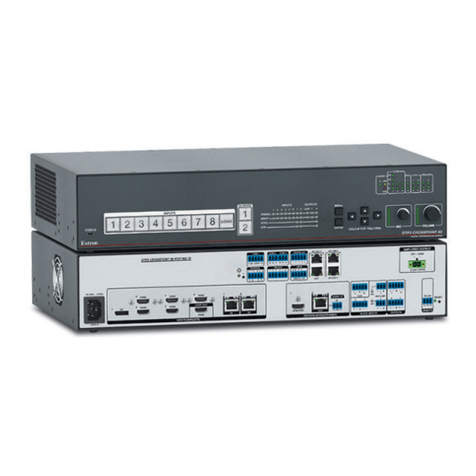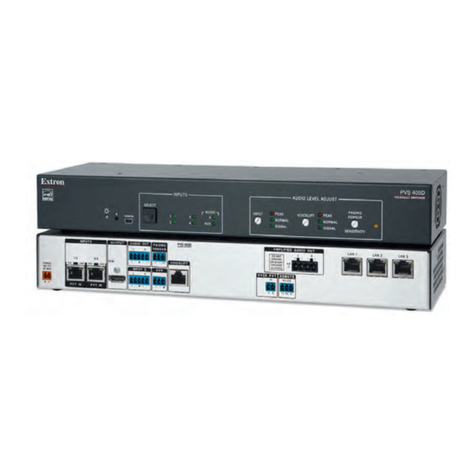VoiceLift connector
iVoiceLift receiver connection — Connect an optional Extron VoiceLift IR receiver to this RJ-45 connector for integration of
the audio output of a VoiceLift Microphone system.
NThe Extron VoiceLift Microphone Kit is an optional accessory which must be purchased separately.
Paging sensor connector
jPaging sensor input — Connect the optional Priority Page Sensor to this port, to enable audio interrupts during paging
system use.
NEnable the switcher’s paging sensor port, using Global Configurator or the MediaLink Switchers (MLS) and PoleVault
Switchers (PVS) control software, available at www.extron.com.
The Extron Priority Page Sensor Kit (part #70-619-01) is an optional accessory which must be purchased separately.
DC Vol/mute connector
kDC Volume control port (Vol/Mute) — This port is used to connect an Extron external volume control module, such as
a VCM, to the PVS 305SA . The range is 0 to 10 V, where 0 V is mute and 10 V is maximum volume. When connected,
the external volume control module is the sole volume controller. Connect the supplied blue, male, 3-pole captive screw
connector to this port.
NDo not control the PVS volume via RS-232 if this port is connected to a VCM 100, or a VC 50. If a VCM is controlling the
volume, an MLC should not control audio volume via RS-232.
Power connector
aDC power connector — When all other cables have been connected, plug the round power jack from the 12 VDC
power
source
into this connector to power the switcher, the PVT wallplates, the MLC controller and, where installed, the VoiceLift
receiver
. One of the five front panel input button LED is lit when the PVS 305SA is receiving power.
NUse only the supplied 12 V, 5A power supply for this switcher.
The PVS 305SA power supply can support a typical system: for example, a PVS 305SA , 4 PVT Wallplates, 2 or 4 speakers,
an MLC 104 IP Plus with an IRCM DV+, and a VoiceLift Microphone system.
If an SCP 104 is used in the system, the MLC 104 IP Plus MUST have its own power supply.
Front Panel Operation and Configuring the PVS 305SA Switcher
For full details of front panel operation and switcher configuration, refer to the PVS 305SA User’s Manual, and the
MLC 104 IP Plus User’s Manual.For VoiceLift and Page Sensor installation and operation details, refer to the VoiceLift
System User’s Manual and the Paging Sensor User’s Manual. All four manuals are available online at www.extron.com.
Front panel operation
NSee the front panel image on page 1 for the location of input buttons, encoders, LEDs, and configuration port.
• To change inputs, select an input button, 1 through 4, (video and audio), or 5 (audio only).
• To adjust audio input levels, rotate the Input encoder through 43 positions in 1 dB steps (-18 to +24 dB, default 0).
• To adjust VoiceLift microphone levels, rotate the MIC encoder through 43 positions in 1dB steps (-18 to +24 dB,
default 0).
NFront panel LEDs indicate input and mic levels (see image at right).
On initial switcher power-up the amplifier level is automatically adjusted to 50%
• To adjust Paging sensitivity, rotate the Paging knob clockwise to increase, and
counter-clockwise to decrease sensitivity.
Configuration
The PVS 305SA switcher can be controlled by MediaLink Controller (MLC) or by an
RS-232 device acting through the MLC. Alternatively, the switcher can be set up and controlled via a host computer
or other device (such as a control system) attached to the switcher’s rear panel RS-232/MLC/IR port. The control
device (host) can use either Extron’s Simple Instruction Set (SIS™) commands, the Global Configurator (GC2)
program for Windows, or the MediaLink Switchers (MLS) and PoleVault Switchers (PVS) control software,
available at www.extron.com. See pages 1 and 2 for connection details.
NConfiguration can also be completed by connecting a 2.5 mm stereo mini cable (part # 70-335-01) to the 2.5 mm
config. port on the front panel. This port uses the same protocol as the RS-232 port on the rear panel.
Firmware updates can be made only via the front panel configuration port.
Refer to the PVS 305SA User’s Manual for a full list of the relevant SIS commands.
NThe PVS 305SA is capable of receiving signals from PVT wallplates located up to 100 feet (30 m) away. The optimum distance
is between 50 and 75 feet (15 and 22 m). The minimum distance is 15 feet (4.6 m).
Cable A carries the video signals and cable B carries the audio signal, vertical sync information and 5 VDC current from the PVS
to power the PVT wallplates.
The ports on the rear of the PVS 305SA are color coded for input number and signal type. To ensure correct cable identification
and connection during installation, a sheet of color coded cable labels is supplied. Refer to “Labeling the A/V Inputs” section in the
Polevault System Installation Manual, for details.
When connecting the TP cables to the PVS 305SA connect input 1’s cable A to the RJ-45 port labeled 1A, and input 1’s cable B to
the RJ-45 port labeled 1B. Likewise, connect input 2, 3, or 4‘s cable A to its corresponding numbered A port, and cable B to its B
port. Do not cross-connect the cables.
RJ-45 termination must comply with the TIA/EIA T 568A or 568B wiring standards for all connectors. The same standard
MUST be used at both ends of all cables. Refer to the PoleVault System Installation Manual for details. The cables supplied
with the PoleVault system are terminated to the TIA 568A standard.
cAux audio input — Input 5 is a dedicated audio only input for an auxiliary, stereo, line-level audio signal from an audio
output source such as a DVI/HDMI device or an MP3 player. Connect the cable from the source to this 5-pole captive
screw connector. The connector can be wired as balanced or unbalanced.
NInput 5 is audio only. No video signals should be connected to this input.
A/V output connectors
dRGB video output — For RGB video, use a VGA cable to connect the projector to this female 15-pin HD connector.
eComposite video output — For composite video, use a cable with an RCA connector to connect the projector to this female
RCA jack.
fAmplified Out — Connect one speaker to each channel marked “L” and “R” (left and right) using the supplied black 4-pin
5 mm connector. Wire red to positive, black to negative. Each channel is rated for 25 W at 2, 4, or 8 Ohm loads. If using
more than one speaker per channel, connect them in parallel.
CDo not tie both L and R outputs to each other and/or to ground as it may short the outputs and damage the amplifier.
NThe speaker setup covers two individual speakers of 8 ohm impedance or two pairs of speakers in parallel, where each channel drives
a maximum output load of 2 ohms.
gLine out audio port — This port is used for connecting an Extron external amplifier, recording, podcasting, or assisted
listening devices. It can be configured via RS-232 for fixed or variable audio output (default is variable). It can be wired for
balanced or unbalanced signals.
Remote control connector
hRS-232/MLC/IR control port — The PVS switcher can be controlled via an RS-232 connection directly from a host computer,
a control system, or a MediaLink Controller (MLC). The MLC provides remote control of input switching and volume.
Connect a cable between this port and the MLC MediaLink Controller. The RS-232 protocol is 9600 baud, 8-bit, 1 stop bit,
no parity, and no flow control. Refer to the MLC 104 IP Plus User’s Manual for full details.
